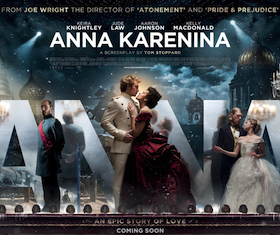
Fortuitously, Dario Marianelli's splendid soundtrack for Anna Karenina is being released today, providing an opportunity to talk about the film even before it arrives in theaters on Friday.
Joe Wright's film, with Tom Stoppard's masterful script, and a dynamite cast, will go into hundreds of Year's Best lists.
Stoppard, whose first successful play, Rosencrantz and Guildenstern Are Dead, 46 years ago, did wonders for Hamlet; the playwright whose Arcadia concatenates centuries and wildly divergent subject as no one else could, here is rewriting and enhancing Tolstoy.
Regardless of how many times you might have read the novel, you will experience something unexpected and yet completely faithful to the novel's essence.

The cast too is a surprise, a good one, including Keira Knightley's Anna, Jude Law's Karenin, Aaron Taylor-Johnson's Vronsky, Kelly Macdonald's Dolly, Matthew Macfadyen's Oblonsky, and more.
Still, a review will have to wait until the Nov. 16 release date, so let's focus on the music and choreography.
Marianelli, 49, Pisa-born, and composer of orchestral music, along with soundtracks for Brothers Grimm, The Soloist, and Pride and Prejudice, provided a great soundtrack for Karenina, well worth hearing by itself.
The Italian composer somehow managed to write "Russian music" that's not imitative or artificial — it is worthy accompaniment to the film: charming, ominous, and dramatic, in turn. The music for the crucial ballroom scene is especially striking.

Photo by Kurt Van der Elst
In the ballroom and several other scenes, the film presents strange and memorable choreography and movements. The artist responsible for that is Sidi Larbi Cherkaoui. (An S.F. Chronicle article describes the actors' struggle realizing Cherkaoui's vision, somehow manages to neglect naming him.)
The Moroccan choreographer, increasingly active in Europe and the U.S., has a hypnotic style, fusing elements of tai chi, belly dance, flamenco, while reinventing Mark Morris the way Stoppard reimagined Tolstoy.
Cherkaoui's signature intertwining arm movements, helping the lovers-to-be becoming one, can be glimpsed in a profile about the choreographer.

